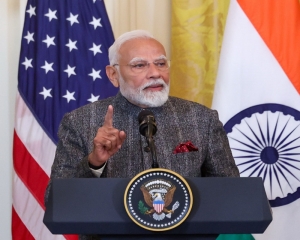Ayodhya witnessed an overwhelming surge of devotees on the sacred occasion of Mauni Amavasya. In the early morning, devotees observed silence as they took a holy dip in the Saryu River, later breaking into chants of ‘Shri Ram’ that resonated across Ayodhya Dham.
The temple town remained packed with worshippers throughout the day, with long queues outside Ram Mandir and Hanumangarhi extending late into the night.
Experts estimate that over 50 lakh devotees have arrived in Ayodhya in the past 72 hours, and the influx is expected to continue until Vasant Panchami.
Pilgrims from the Maha Kumbh in Prayagraj are now heading to Ayodhya. Anticipating this surge, Chief Minister Yogi Adityanath had instructed officials to ensure seamless crowd management.
Under his guidance, principal secretaries and district officials implemented meticulous arrangements for smooth darshan and puja. CM Yogi is personally monitoring the situation to ensure the efficient management of the influx, officials said here.
Thousands of devotees thronged the Saryu ghats for a holy dip, with Chaudhary Charan Singh Ghat seeing the largest influx. After their ritual bath, many proceeded to Hanumangarhi before seeking Ram Lalla’s darshan. A massive crowd stretched from Shringar Haat to the temple premises, creating a deeply spiritual atmosphere.
Similar scenes were observed at the Ram Temple, where devotees queued up in large numbers for darshan.
Meanwhile, the growing influx of devotees in Ayodhya Dham has significantly boosted local businesses. From ‘prasad’ sellers to hoteliers, the surge in footfall has led to a sharp increase in their sales and profits. Homestay operators, too, are witnessing a rise in bookings as pilgrims flock to the holy city, adding to Ayodhya’s economic activity.
To ensure the safety and well-being of the massive crowd arriving in Ayodhya Dham, authorities have implemented strict security and health measures. The entry of all types of vehicles into the fair area has been completely restricted, with heavy police deployment at key locations to maintain order.
The Health department is on high alert, with all doctors’ leave cancelled until Vasant Panchami. Emergency services will remain operational 24x7 to handle any medical needs.
Chief Medical Officer Dr Pushpendra Kumar confirmed that 13 temporary health camps will continue to function until February 26 to provide immediate medical assistance to pilgrims.
Meanwhile, IG Praveen Kumar stated that traffic has been rerouted to manage the massive footfall. Large vehicles have been stopped on the highways, and alternative routes have been designated to prevent congestion in and around Ayodhya.
With the growing number of devotees in Ayodhya Dham, authorities have significantly increased accommodation capacity.
Municipal Commissioner Santosh Sharma confirmed that arrangements have been made to house around 30,000 devotees in shelter areas to ensure their comfort.
In light of the ongoing preparations, ADG, Lucknow Zone, SB Shirodkar, visited Ayodhya on Wednesday to assess security and management efforts, including arrangements at Ayodhya Dham Railway Station. He was accompanied by DIG, Devipatan Division, Amit Pathak.
Additionally, Divisional Commissioner Gaurav Dayal and IG Praveen Kumar reviewed major locations from the control room.
Divisional Commissioner Gaurav Dayal, IG Praveen Kumar, District Magistrate Chandra Vijay Singh, SSP Rajkaran Nair, and Municipal Commissioner Santosh Sharma are continuously monitoring the situation, conducting inspections both during the day and late at night.
Nepal MP Binita Kathayat
praises Modi, Yogi
Nepal’s MP from the Rashtriya Swatantra Party (RSP), Binita Kathayat, expressed her gratitude to Prime Minister Narendra Modi and Uttar Pradesh Chief Minister Yogi Adityanath after taking a holy dip at Maha Kumbh.
Accompanied by her family, she also visited Ram Mandir in Ayodhya, appreciating the grand arrangements made for the historic event. Kathayat further announced her plans to visit Lucknow to meet CM Yogi, where she aims to discuss strengthening ties between Nepal and India, particularly with Uttar Pradesh.


























